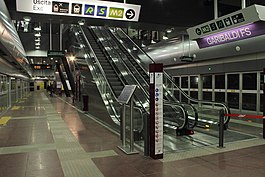
Back Ligne 5 du métro de Milan French Linea M5 (metropolitana di Milano) Italian ミラノ地下鉄M5線 Japanese 밀라노 지하철 5호선 Korean Linia M5 (metropolitana de Milan) LMO Lijn 5 (metro van Milaan) Dutch Linha 5 del mètro de Milan Occitan Линия M5 (Милан) Russian 米蘭地鐵5號線 Chinese
| M5 | |||
|---|---|---|---|
 | |||
 Garibaldi FS station | |||
| Overview | |||
| Status | Operational | ||
| Locale | Milan, Italy | ||
| Termini | |||
| Connecting lines | |||
| Stations | 19 | ||
| Service | |||
| Type | Rapid transit | ||
| System | Milan Metro | ||
| Operator(s) | Azienda Trasporti Milanesi | ||
| Rolling stock | AnsaldoBreda Driverless Metro | ||
| Daily ridership | 130,000 (October 2015)[1] | ||
| Ridership | 37 million (2022)[2] | ||
| History | |||
| Opened | 10 February 2013[3] | ||
| Technical | |||
| Line length | 12.9 km (8.0 mi)[4][5] | ||
| Number of tracks | 2 | ||
| Track gauge | 1,435 mm (4 ft 8+1⁄2 in) standard gauge | ||
| Electrification | 750 V DC third rail | ||
| Operating speed | 30 km/h (19 mph) (average) 80 km/h (50 mph) (maximum) | ||
| |||
Line 5 is an underground rapid transit line in Milan, Italy, part of the Milan Metro. The line, also known as M5 or the Lilac Line (Linea Lilla in Italian), is 12.8-kilometre (8.0 mi) long and goes through the city from the north to the north-west.[4] It opened in stages between 2013 and 2015.[3][6][5][7]
The line operates using AnsaldoBreda Driverless Metro vehicles.[8][9]
- ^ "Delrio sulla M5: "Esempio virtuoso di infrastruttura"". Milano Today. 26 October 2015. Retrieved 27 October 2015.
- ^ "Tpl Milano, la metro 5 ha ricavi per 85 milioni. Passeggeri? +45%". AUTOBUS Web - La rivista del trasporto pubblico in Italia (in Italian). 17 April 2023. Retrieved 4 July 2023.
- ^ a b "Milano Metro's first driverless line inaugurated". Railway Gazette International. 6 February 2013. Retrieved 6 June 2015.
- ^ a b "Sostenibilità" [Sustainability] (in Italian). Metro 5 SpA. Retrieved 6 June 2015.
- ^ a b Sadler, Katie (1 May 2015). "Milan Metro Line 5 extension begins driverless operation". Eurotransport. Retrieved 6 June 2015.
- ^ "Milano extends driverless Line M5". Railway Gazette International. 7 March 2014. Archived from the original on 9 June 2015. Retrieved 6 June 2015.
- ^ Chiandoni, Marco (1 May 2015). "Milan Line 5 extension opens". International Railway Journal. Retrieved 6 June 2015.
- ^ "Milan Metro". Railway Age. March 2007. Retrieved 17 November 2009.
- ^ "500 million euro Italian metro deal". International Railway Journal. April 2006. Retrieved 17 November 2009.
